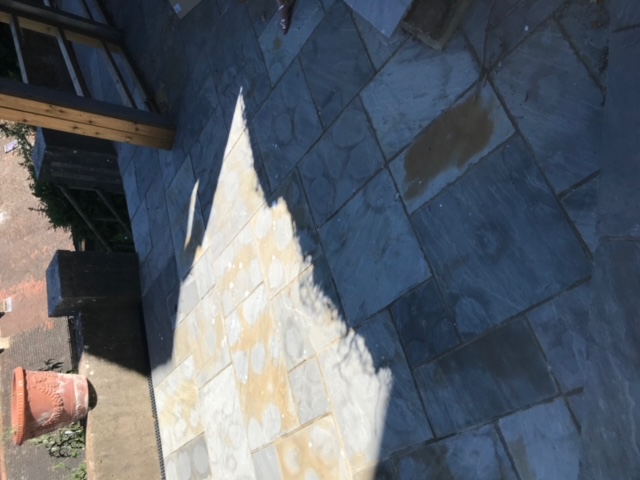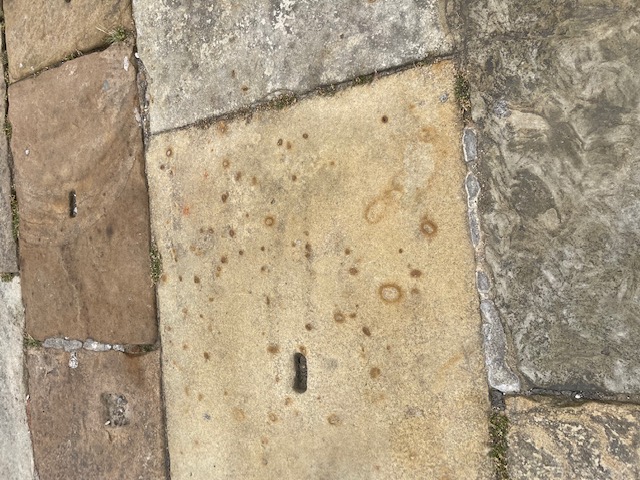There are many reasons rust stains can appear on paving materials, some are easily fixed and some can prove very difficult to resolve, below we are going to try to tackle the most common problems we have encountered over the years. If you are not used to installing natural stone products or are having a contractor install these materials for you, it will be well worth reading the first point carefully as this is the most difficult to rectify and can in some cases result in your paving needing expensive remedial repair work.
1. Rust Stains on Natural Stone After Acid Cleaners
The number one problem we have encountered over the years is contractors not correctly removing mortar stains during paving installation, and then leaving these to dry hard on the surface of the stone. They then attempt to remove these stains with Brick Acid (Hydrochloric acid). However, in a large number of natural stone products, the acid can react with the minerals contained within natural stone (especially Storm Grey / Kandla Sandstone and Silver Granite) bringing Iron oxide to the surface of the paving. As a result this creates rusty marks that can be isolated or in extreme cases covering the whole surface of the stone.
In the past your contractor would lay concrete paving slabs and clean up all the mortar spills and staining at the end of the job with an acid wash. This is not the case with natural stone. Brick Acid is too harsh to be used on any natural stone surface, it’s extremely corrosive and can change the appearance of the surface of the stone and will cause chemical reactions within the stone itself as detailed above.
We have over the years also seen acid cleaners, in some cases pulling minerals to the surface from mortar point and cement render. We would always tell any of our customers to stay well away from acid based cleaning products unless you have specific knowledge of their correct application.
Occasionally when contractors call us saying they have rust marks appearing on the newly laid patio, we would ask if they have used acid to clean mortar stains from paving, and they will reply by saying they have not used any acid cleaners only soap and water. I can assure everyone that this soap and water will not cause any issues to the surface of any natural stone product. Sometimes It’s hard to admit mistakes, but if we are presented with the correct information we can try to point you in the direction of a possible solution, denying the fact that it’s happened will not help anyone.
Please see the photo below showing the brown (Rust) marks left after an acid based clear has been used.

NEVER USE BRICK ACID ON NATURAL STONE SURFACES !!
How to Remove Rust Stains on Natural Stone After Acid Cleaners
If you find yourselves in this situation there are a few products on the market that can help with these types of stains, one which we have started to hear good things about is ‘Rob Parkers Best Rust Remover’. Please see link to their website below:
Do not use it on limestone or polished stone surfaces, as this product will burn the stone surface.
We have not tested these products ourselves yet, and I would suspect that if you have extensive staining across the whole surface of the stone, where a very strong acid cleaner has been used and left to dwell, even this product is going to have limited success. When we have done more testing with this product we will update our finding on our news section accordingly.
Ultimately it is the responsibility of the contractor undertaking the works, to rectify any issues they have caused by using acid cleaners incorrectly. Ignorance of the fact that these products are not suitable is not a good enough excuse, you must fully understand the products you are installing and the chemicals you are using on them.
2. Garden Furniture Can Create Rust Stains on Natural Stone
Another common problem we come across is Rust staining left by water running off Iron or steel garden furniture or tools that have been left touching the surface of the stone. The metal in the furniture starts to oxidise (Rusting) and these deposits sit on the surface of the paving material leaving unsightly brown staining. This is not just a problem that is isolated to natural stone all paving materials from concrete to porcelain slabs will stain if rust is allowed to sit on the surface for long periods of time.
Best Way to Remove Rust Caused by Garden Furniture on Natural Ston
In most cases you can see very good results using a rust remover, these products are widely available, but we have used ourselves the RUST-OFF from Universeal, and we have seen very good results. In fact, the sandstone paving used in the video was from our Portsmouth Display that had a Barrel sat on the surface for many years and It left quite a large stain, which you will see was removed easily.
3. Natural Causes of Rust Stains on Natural Stone
There is a large range of natural stone materials that will contain some level of iron minerals within the structure of the stone naturally. On occasion, these iron deposits can leach out of the stone and appear on the surface after oxidising (Rusting). This is caused by the natural weathering of the stone and therefore is not avoidably, although its quite rare and easily removed. These stains will normally appear as small circles of rusty coloured marks on the surface of the stone, generally, these stains are easily cleaned off using RUST-OFF from Universeal, link above.
Please see the image below showing the iron deposit present well below the original surface in Yorkstone installed at Whitby Harbour, North Yorkshire, these marks have appeared after centuries of weathering by the sea has removed the stone’s original surface exposing the Iron deposits below.

Please be aware that sometimes these marks especially in Grey and Black granite might appear as Dark patches as well as rust coloured marks, the same treatment is needed to remove them.
4. How Fertilisers Cause Rust Stains on Natural Stone
Certain lawn feeds and weed killers also contain Iron sulphates. These can leave rust marks on the surface of your paving, this is not unique to natural stone products, these products if left on the surface will stain all paving materials from concrete to Porcelain. These marks usually appear as small brown rust marks spread across the surface of the stone. We would always recommend you don’t store these products on your patio and if you are applying these materials to your lawn and some spills on the surface of the paving you should always sweep them off immediately.
Easy Way to Remove Rust Stains from Natural Stone Fertilisers
If you already have staining from fertiliser present on your patio we would firstly recommend giving your patio a good jet wash and if the stains persist try using RUST-OFF from Universeal, link above.

